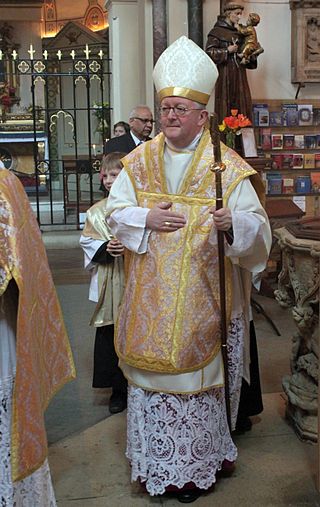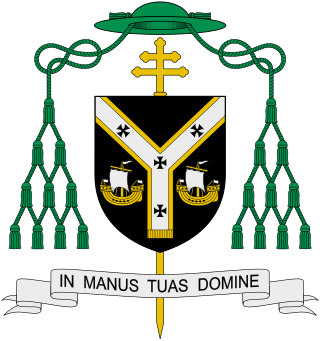
The Latin Patriarchate of Jerusalem is the Latin Catholic ecclesiastical patriarchate in Jerusalem, officially seated in the Church of the Holy Sepulchre. It was originally established in 1099, with the Kingdom of Jerusalem encompassing the territories in the Holy Land newly conquered by the First Crusade. From 1374 to 1847 it was a titular see, with the patriarchs of Jerusalem being based at the Basilica di San Lorenzo fuori le Mura in Rome. A resident Latin patriarch was re-established in 1847 by Pius IX.

The Roman Catholic Diocese of Clifton is a Roman Catholic diocese centred at the Cathedral Church of Saints Peter and Paul in Clifton, England.

The Bishop of Clifton is the Ordinary of the Roman Catholic Diocese of Clifton in the Province of Birmingham, England.
The Bishop of Hexham and Newcastle is the Ordinary of the Roman Catholic Diocese of Hexham and Newcastle in the Province of Liverpool, known also on occasion as the Northern Province.

The Archbishop of Birmingham heads the Roman Catholic Archdiocese of Birmingham in England. As such he is the metropolitan archbishop of the Province of Birmingham. The archdiocese covers an area of 8,735 km2 (3,400 sq mi) and spans of the counties of Oxfordshire, Staffordshire, West Midlands, Warwickshire and Worcestershire. The see in the City of Birmingham where the archbishop's seat is located at the Metropolitan Cathedral and Basilica of Saint Chad.

The Archbishop of Cardiff is the ordinary of the Roman Catholic Archdiocese of Cardiff.

The Bishop of Menevia is the ordinary of the Diocese of Menevia in the Province of Cardiff in the Catholic Church in Wales.

The Catholic Diocese of Westminster is an archdiocese of the Latin Church of the Catholic Church in England. The diocese consists of most of London north of the River Thames and west of the River Lea, the borough of Spelthorne, and the county of Hertfordshire, which lies immediately to London's north.

The Roman Catholic Archdiocese of Cardiff is an archdiocese of the Latin Church of the Catholic Church which covers the south-east portion of Wales and the county of Herefordshire in England. The Metropolitan Province of Cardiff therefore covers all of Wales and part of England. Cardiff's suffragan dioceses are the Diocese of Menevia and the Diocese of Wrexham.
The Apostolic Vicariate of the Lancashire District was an ecclesiastical jurisdiction of the Catholic Church in England. It was led by a vicar apostolic who was a titular bishop. The apostolic vicariate was created in 1840 and was replaced by two dioceses in 1850.
The Apostolic Vicariate of the Midland District was an ecclesiastical jurisdiction of the Roman Catholic Church in England and Wales. It was led by an apostolic vicar who was a titular bishop. The Apostolic Vicariate of the Midland District was created in 1688 and changed its name to the Central District in 1840. It was dissolved in 1850 and was replaced by two dioceses.
The Apostolic Vicariate of the Northern District was an ecclesiastical jurisdiction of the Roman Catholic Church in England and Wales. It was led by a vicar apostolic who was a titular bishop. The Apostolic Vicariate of the Northern District was created in 1688 and dissolved in 1850 and was replaced by the Diocese of Hexham, which changed to the Diocese of Hexham and Newcastle in 1861.
John Leyburn was an English Roman Catholic bishop who served as the Vicar Apostolic of England from 1685 to 1688 and then when it was divided served as the Vicar Apostolic of the London District from 1688 to 1702. He was not only a theologian, but also a mathematician, and an intimate friend of Descartes and Hobbes.

Universalis Ecclesiae was a papal bull of 29 September 1850 by which Pope Pius IX recreated the Roman Catholic diocesan hierarchy in England, which had been extinguished with the death of the last Marian bishop in the reign of Elizabeth I. New names were given to the dioceses, as the old ones were in use by the Church of England. The bull aroused considerable anti-Catholic feeling among English Protestants.
Michael Ellis was an English Benedictine monk who was a prelate of the Catholic Church. He served as the first Vicar Apostolic of the Western District of England and Wales, and subsequently Bishop of Segni in Italy.

The Roman Catholic Diocese of Hexham and Newcastle is a Latin Church diocese of the Catholic Church, centred on St Mary's Cathedral in the city of Newcastle upon Tyne in England. The diocese is one of the six suffragan sees in the ecclesiastical Province of Liverpool and covers the historic boundaries of County Durham and Northumberland.
George Hilary Brown was an English prelate who served as the first Roman Catholic Bishop of Liverpool from 1850 to 1856.

Thomas Joseph BrownOSB was a bishop of the Roman Catholic Church. He served for two ecclesiastical jurisdictions, first as the Vicar Apostolic of the Welsh District from 1840 to 1850, then as Bishop of Newport and Menevia from 1850 to 1880.
Joseph William Hendren OFM (1791–1866) was an English Roman Catholic bishop. He served three ecclesiastical jurisdictions, first as the Vicar Apostolic of the Western District (1848–1850), then Bishop of Clifton (1850–1851), and finally Bishop of Nottingham (1851–1853).
Giovanni Francesco Nicolai, O.F.M. was a Roman Catholic prelate who served as Vicar Apostolic of Houkouang (1696–1737), Titular Archbishop of Myra (1712–1737), and Titular Bishop of Berytus (1696–1712).










